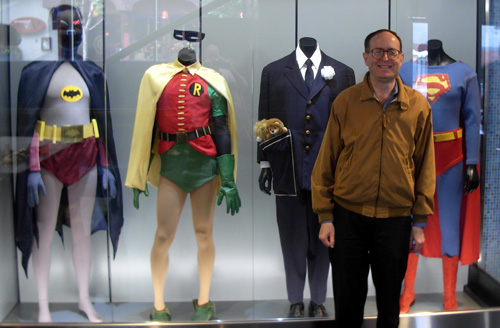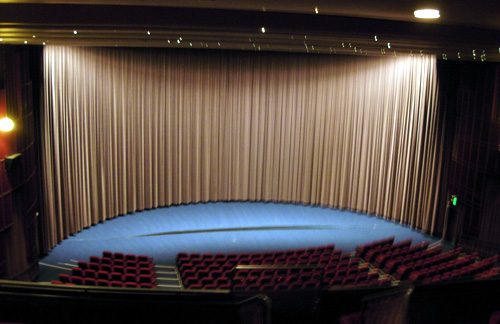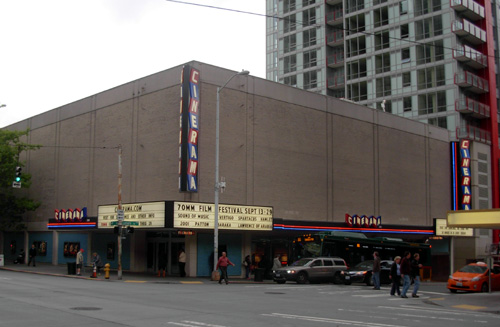Seattle Cinerama 70mm Film Festival 2013 |
Read more at in70mm.com The 70mm Newsletter |
| Written and photographed by: Howard B. Haas, Philadelphia, USA | Date: 01.10.2013 |
 A chocolate aroma, from freshly prepared
chocolate popcorn, greeted me at the sidewalk in front of the Seattle
Cinerama, on the 19th of September. The marquee listed 8 epic 70mm films,
for the three week 70mm
Film Festival of
September 2013. I had traveled from Philadelphia for my first visit to
Seattle, for the 2nd week of the festival, for what was to be an
exhilarating experience of enjoying some of the most famous ever 70mm movies
on a 90 feet wide screen. Five weeks earlier, I saw on Facebook a friend's
“like” of the Cinerama's post that there would soon be a 3 week festival of
70mm and 3 strip Cinerama movies. One week later, the film titles were
posted and on that day, I booked one of the last seats on the airplane, and
reserved a room at a hotel. A chocolate aroma, from freshly prepared
chocolate popcorn, greeted me at the sidewalk in front of the Seattle
Cinerama, on the 19th of September. The marquee listed 8 epic 70mm films,
for the three week 70mm
Film Festival of
September 2013. I had traveled from Philadelphia for my first visit to
Seattle, for the 2nd week of the festival, for what was to be an
exhilarating experience of enjoying some of the most famous ever 70mm movies
on a 90 feet wide screen. Five weeks earlier, I saw on Facebook a friend's
“like” of the Cinerama's post that there would soon be a 3 week festival of
70mm and 3 strip Cinerama movies. One week later, the film titles were
posted and on that day, I booked one of the last seats on the airplane, and
reserved a room at a hotel. Why did I travel to Seattle for the film festival? Philadelphia's last movie theater that was equipped with 70mm projectors, the Sameric, built in 1928 as the Boyd, and which in 1953 became Philadelphia's only theater for 3 strip Cinerama, had closed in 2002. As a volunteer, I lead the nonprofit organization working to save it www.FriendsOfTheBoyd.org). I've seen many 70mm epics at the Uptown in Washington D.C, on its huge curved screen, originally installed for Cinerama, but no classics have been shown since AMC took over. Few screens worldwide as large as Seattle's are still equipped to show 70mm films. Seattle's festival was a rare opportunity to see 70mm classics on an enormous screen. The Seattle Cinerama was built in 1963. Microsoft's co-founder Paul Allen saved it and reopened it in 1999. New movies are shown on a huge non-curved screen that is normally in front of the Cinerama screen. The Cinerama's manager told me that before the festival it took a day and a half to remove the non-curved screen and speakers behind it, in order to expose the curved screen. In the lobby, there are two display cases with rotating displays of movie & TV costumes owned now by Paul Allen or by his company. Costumes from TV heroes Batman (worn by Adam West), Robin (Burt Ward), Captain Kangaroo (Bob Keeshan), and Superman (George Reeves) were in one display. The other display had TV's Battlestar Galactica costumes, one from “Logan's Run” (Farrah Fawcett-Majors), and from the film “Star Trek: Nemesis” (Patrick Stewart). |
More in 70mm reading: Seattle Cinerama Big Screen 70MM Festival Rare, Classic Films to Screen at Seattle Cinerama Theatre Seattle's Cinerama Theatre is getting technical upgrade Internet link: seattlecinerama.com FriendsOfTheBoyd.org |
 During the festival, movies were wonderfully presented in a traditional
fashion that is almost never experienced elsewhere any more. No inane
preshow assaulted the senses. The lights dimmed. Movies that had overture
music played the music in the proper fashion, with the curtain still closed.
The curtain opened, not on a blank screen, but with the start of the feature
film itself. The curtain closed at intermissions, and it closed again as the
movie ended. As each film ended, the audience applauded. All prints were
very good prints, and were beautiful restorations. Of the 8 films in 70mm,
“Spartacus” and “Baraka” had sound on the film itself. The
other 70mm films had digital sound, DTS 8 track sound (5 tracks behind the
screen, 2 for the auditorium's sides and 1 at the auditorium rear). The
audio of the films was piped into the restrooms. During the festival, movies were wonderfully presented in a traditional
fashion that is almost never experienced elsewhere any more. No inane
preshow assaulted the senses. The lights dimmed. Movies that had overture
music played the music in the proper fashion, with the curtain still closed.
The curtain opened, not on a blank screen, but with the start of the feature
film itself. The curtain closed at intermissions, and it closed again as the
movie ended. As each film ended, the audience applauded. All prints were
very good prints, and were beautiful restorations. Of the 8 films in 70mm,
“Spartacus” and “Baraka” had sound on the film itself. The
other 70mm films had digital sound, DTS 8 track sound (5 tracks behind the
screen, 2 for the auditorium's sides and 1 at the auditorium rear). The
audio of the films was piped into the restrooms. On my day of arrival, the movie shown that Thursday evening was “Patton” (1970). Two months previously, I saw “Patton” in 70mm at the AFI Silver Theatre in the Washington DC area. I had sat closer to the screen (40 feet wide for scope films) that I would normally, to see the 70mm enhanced resolution details. I was enthralled by the experience, and appreciated the opportunity to see the movie again in 70mm, but this time from the 2nd row of the Seattle Cinerama balcony to get more of a wide screen perspective of experiencing the whole film at once, directly in front of me, rather than looking up from the main (aka orchestra, or stalls) floor. “Patton” was a D-150 movie, meant for a hugely curved screen, which the Cinerama has. In the balcony, I heard rear surround sound from “Patton”. I had read that some 70mm films were failing at the box office in the end of the 1960s but “Patton” was popular because during those turbulent times of the Vietnam War era, the movie appealed to many. On the right, President Nixon watched it many times in the White House. On the left, antiwar activists appreciated the movie's depictions of the horrors of war. The next day, Friday, I attended the afternoon showing of Hitchcock's “Vertigo” (1958), a blow up from 35mm to 70mm. I had seen “Vertigo” at its 1996 70mm restoration release, on the huge screen of the Uptown in DC, but it was a thrill to see it again. The “Vertigo” print was gorgeous. Its surround sound primarily consisted of birds chirping, which made me think of a later Hitchcock film. I returned for the crowded Friday evening screening of “Lawrence of Arabia” (1962). This was the only time that I sat in the main floor, sitting in the 2nd row of the second section, not the section closest to the screen. Personally, I didn't like looking up at the massive screen, but I was able to see even more of the gorgeous detail. This print was from the “color corrected” restoration of 2003 though the print itself may have been newer. Seeing the restored roadshow 70mm print in 1989 (before the color corrected restoration) at the Uptown in DC was one of the greatest movie experiences I've had. This summer, I had seen the recent, even prettier, 4k restoration, but 4k is not sufficient to see all the original detail. | |
 Saturday, I attended both films, both directed by
Stanley
Kubrick. The afternoon attraction was “Spartacus”
(1980). I had seen the 1991 roadshow
restoration in 70mm on a screen that
was 40 feet wide for scope, the NYC Cineplex Odeon Worldwide, since closed,
and was excited to see it on the huge Cinerama screen. It was also a
gorgeous print. Saturday, I attended both films, both directed by
Stanley
Kubrick. The afternoon attraction was “Spartacus”
(1980). I had seen the 1991 roadshow
restoration in 70mm on a screen that
was 40 feet wide for scope, the NYC Cineplex Odeon Worldwide, since closed,
and was excited to see it on the huge Cinerama screen. It was also a
gorgeous print. “2001: A Space Odyssey” (1968) was Saturday's evening feature and drew a huge crowd. I had seen a new 70mm print in the year 2001 on the huge curved screen at the Uptown in DC, the theater which hosted its world premiere. That DC showing had been another screening that was among the most spectacular movie experiences that I've had. I had remembered the extensive surround sound. The Cinerama showed a new print commissioned last year by theater savior Paul Allen. The Cinerama screening began with a dimming of lights except the auditorium's starry ceiling, which after a short pause also dimmed, but was an atmospheric start. The surround sound, like I had heard in DC, was again all encompassing, and the experience again was thrilling. I skipped Sunday's afternoon's showing of Branagh's "HAMLET" (1996) which I had seen in 70mm at the Paris in NYC, and the evening show of “Baraka” (1992) to have some time for more general sightseeing in Seattle, a city with many worthwhile attractions. I was told they were both great prints. |
|
 Monday evening, I enjoyed “The Sound of Music” (1965). That epic film
I had also seen in 70mm at the Uptown in DC, but at a time in 1991 when
several classic films were shown in lieu of a new feature. This screening
looked like a restored print, and was very beautiful. There was quite a bit
of surround sound, including the thunderstorm, the organ at the church
wedding and the outdoor singing contest. On Sunday, in order to see other
historic movie theaters in Seattle, I had watched two films projected in 2k.
2K doesn't carry the same resolution or look of 35mm, much less 70mm.
Compared to those films, “The Sound of Music” was positively
eyepopping and whether it was the 70mm resolution or the cinematography in
general, the nuns really appeared to be popping out of the screen. Monday evening, I enjoyed “The Sound of Music” (1965). That epic film
I had also seen in 70mm at the Uptown in DC, but at a time in 1991 when
several classic films were shown in lieu of a new feature. This screening
looked like a restored print, and was very beautiful. There was quite a bit
of surround sound, including the thunderstorm, the organ at the church
wedding and the outdoor singing contest. On Sunday, in order to see other
historic movie theaters in Seattle, I had watched two films projected in 2k.
2K doesn't carry the same resolution or look of 35mm, much less 70mm.
Compared to those films, “The Sound of Music” was positively
eyepopping and whether it was the 70mm resolution or the cinematography in
general, the nuns really appeared to be popping out of the screen.I couldn't stay for the last weekend during which two 3 strip films were shown, “This is Cinerama” (which I've seen in its 3 strip glory in Bradford, England) or “How the West Was Won” which I hope to see in a future year. Except for "Vertigo", all the films that I did see were close to three hours, or even longer, so after all those lengthly films, the five and a half hour plane trip return to Philadelphia went by in no time. I hope one day to return to Seattle for more general sightseeing, including the EMP museum which has artifacts from films & TVs that are also owned by theater savior Paul Allen. |
|
| Go: back - top - back issues - news index Updated 21-01-24 |
